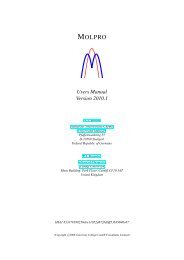CHAPTER II. POTENTIOMETRY AND REDOX TITRATIONS I ...
CHAPTER II. POTENTIOMETRY AND REDOX TITRATIONS I ...
CHAPTER II. POTENTIOMETRY AND REDOX TITRATIONS I ...
- No tags were found...
You also want an ePaper? Increase the reach of your titles
YUMPU automatically turns print PDFs into web optimized ePapers that Google loves.
Both SO − 4 + Ag 2+ are powerful oxidants. Excess reagent is destroyed by boiling.boilingS 2 O 2− 8 + 2H 2 O ⎯⎯→ 4SO 2− 4 + O 2 + 4H +The SO − 4 + Ag 2+ mixture oxidizes Mn 2+ to MnO − 4 , Ce 4+ to Ce 3+ , Cr 3+ to Cr 2 O 2− 7 ,and VO 2+ to VO + 2 .2. Silver(<strong>II</strong>)Silver(<strong>II</strong>) oxide (AgO) dissolves in concentrated mineral acids to give Ag 2+ , withoxidizing power similar to S 2 O 2− 8 + Ag + combination. Excess Ag 2+ can beremoved by boiling.boiling4Ag 2+ + 2H 2 O ⎯⎯→ 4Ag + + O 2 + 4H +3. Sodium BismuthateSolid NaBiO 3 has an oxidizing strength similar to that of Ag 2+ and S 2 O 2− 8 .Excess solid oxidant is removed by filtration.4. Hydrogen PeroxideH 2 O 2 is a good oxidant in basic solution. It can transform Co 2+ to Co 3+ , Fe 2+ toFe 3+ , and Mn 2+ to MnO 2 . In acidic solution it can reduce Cr 2 O 2− 7 to Cr 3+ andMnO − 4 to Mn 2+ . Excess H 2 O 2 spontaneously disproportionates in boiling water.boiling2H 2 O 2 ⎯⎯→ O 2 + 2H 2 Ob) Prereduction1. Stannous ChlorideSnCl 2 can be used to prereduce Fe 3+ to Fe 2+ in hot HCl. Excess reductant isdestroyed by adding excess HgCl 2 .Sn 2+ + 2HgCl 2 → Sn 4+ + Hg 2 Cl 2 + 2Cl −9











![Hetero [6+3] Cycloaddition of Fulvenes with N-Alkylidene Glycine ...](https://img.yumpu.com/35423358/1/190x245/hetero-6-3-cycloaddition-of-fulvenes-with-n-alkylidene-glycine-.jpg?quality=85)




